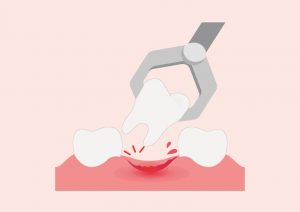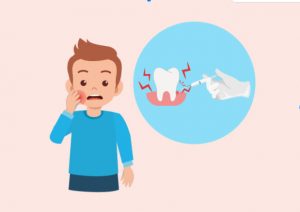Dental Extraction is a removal of a tooth from the mouth. Dentists perform this procedure for a wide variety of reasons.

Here are some of the reasons for tooth extractions:
- Tooth decay – If the decay is severely advanced and the nerves and blood vessels in the tooth have been infected and are unsuitable for root canal treatment.
- Impacted wisdom teeth – Sometimes, our mouths are simply not big enough to accommodate these teeth. The teeth become impacted (stuck), which can cause infection and pain.
- Periodontal disease – Bacterial infection under the gum damages the tissue which connects the tooth to the gum; as the disease progresses, the bone anchoring the tooth to the jaw begins to dissolve, resulting in the tooth becoming loose.
- Teeth damaged by trauma.
- Having certain medical conditions that may require tooth extraction.
How we conduct extraction and surgical procedures at DP Dental
- Your dentist will examine your tooth and explain the reasons why your tooth needs to be extracted,
- An x-ray will be taken to help plan the best way to remove the tooth and to see if an abscess is present.
- If an abscess is present, your dentist will give you a course of antibiotics before extracting the tooth.
- You must list every medication you consume even if you have purchased it over the counter, as some medications can complicate an extraction.
- Tell your dentist if you are anxious about the procedure as sedation is available. If your dentist does not carry out sedation, he will refer you to a practice that does.

How the extraction is carried out
There are two types of extraction:

Simple extraction
Dentists perform a simple extraction when the tooth can is easily seen in the mouth. Your dentist will give you a local anaesthetic to numb the area around the tooth. When the anaesthetic has taken effect, and the area around the tooth is numb, the dentist will grasp the tooth using a pair of forceps. You will feel pressure but NO pain. The dentist will then move the forceps back and forth to loosen the tooth to extract the tooth.

These procedures are carried out on teeth which:
- Cannot be seen in the mouth but are present below the gum.
- Partially showing through the gum
- Broken off at gum level.
Dentists perform a simple extraction when the tooth can is easily seen in the mouth. Your dentist will give you a local anaesthetic to numb the area around the tooth. When the anaesthetic has taken effect, and the area around the tooth is numb, the dentist will grasp the tooth using a pair of forceps. You will feel pressure but NO pain. The dentist will then move the forceps back and forth to loosen the tooth to extract the tooth.
Things to note after an extraction:

After the extraction, a blood clot will form in the socket where the tooth used to be, which is normal.

It is important to note that vigorous rinsing or poking the site with your tongue or finger can delay the process of healing. So be cautious!

If the socket does start to bleed after you have left the dental practice, place the clean gauze provided to you over the extraction site and apply pressure by biting down.

The bleeding will usually stop within a few minutes.

If the bleeding persists, please don’t hesitate to contact your dentist for further advice.

Remember that your mouth will still be numb for 1-2 hours after the local anaesthetic.

You are advised not to bite your cheek or tongue.

Also, remember not to drink any hot liquids as it may inadvertently burn your mouth.

Avoid Smoking and drinking Alcohol for 24 hours as these can affect the healing process.

You may experience some discomfort after the anaesthetic has worn off. Take a household painkiller (headache medicine) following the manufacturer's instructions. PLEASE REFRAIN from taking Aspirin as this may cause the socket to bleed.
